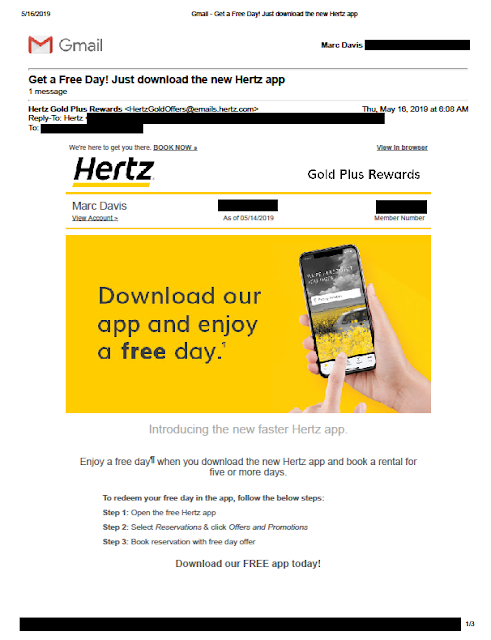Hertz has had a challenging time with their customer app. In fact, execution of their app redesign was so bad that, only a few weeks
ago, Hertz
sued their marketing partner Accenture (pdf here).
So, when Hertz finally had a
newly redesigned app ready
for prime time, it made sense to promote it.
When promoting
engagement of an app, offering an incentive for use is an effective tool. This
week, Hertz is offering customers a free car rental day. I recently received
the below email as a Hertz Gold Plus Rewards member.
 |
 |
| Hertz new app promotional email with message that "Terms Apply" |
According to the email,
I can get a free rental day when I use the app. The headline message has an
asterisk—or, in this case, a paragraph symbol (¶)—indicating there is a Disclosure on
the page regarding the offer. Based on the corresponding paragraph symbol, the
Disclosure reads simply, Ҧ Offer ends 06/30/19. Taxes and fees excluded. Terms
apply.”
OK, so what are the
terms?
I thought the landing
page might perhaps have more information; however, it includes only the same
Disclosure that “Terms Apply.”
 |
| Landing page. Disclosure circled. |
I thought there might be
at least a link here to the terms that apply, but there is not. We know from
the email that the offer is valid on rentals of 5 days or more and expires on
June 30, 2019. The landing page includes the additional Disclosure that the
offer is available only in the United States and Canada, but what else? Is it
valid in Hawaii? At airport pick-ups? For Hertz Local Edition? Can I combine it with a free upgrade offer? Do
AAA discounts or my CDP number combine with this offer? Do I need to
reserve at least 7 days in advance?
These are details, but
are relevant details that may or may not drive decision. By not sharing them and merely
stating, “Terms apply”, this email and related web page merit a Fail for Creative.
Update 5/17/19: Hertz communicated to me via Twitter:
Hello Marc. When on the app, you will stay on the home page, under the YouTube video, you will click on the promotion that states " App Exclusive", when you click that you will see at the top "Get a free day when you rent for five" and scroll up. It states the offer summary and the Terms and Conditions. If you are still having trouble, please reach back out for further assistance. We will gladly walk you through the steps. Thank you. -DRThis reinforces my point -- that terms are not upfront and hard to find. There is no reason both the email and landing page could have disclosed at least "Please review the offer in our new app for additional terms that apply."
Lesson:
When you present an offer, share the terms of the offer upfront. At the very least, know what they are.








